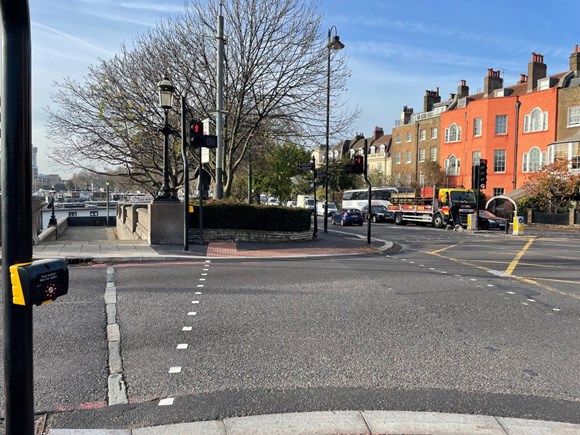
Tuesday 30 Nov 2021
TfL Press Release - TfL completes work to improve safety on Battersea Bridge

PN-137
- TfL has completed work on a new signalised pedestrian crossing on the north side of the bridge
- The speed limit has also been reduced from 30mph to 20mph
- The changes were brought forward following the tragic death of Jack Ryan earlier this year, who was killed following a collision with a vehicle
- Improving safety on London’s roads is a vital part of TfL's Vision Zero commitment to eliminating death and serious injury on the transport network
Transport for London (TfL) has completed work to make walking at Battersea Bridge safer. The changes are part of TfL’s Vision Zero commitment to improve road safety with the goal of eliminating death and serious injury on the road network. This work was brought forward following the tragic death of Jack Ryan earlier this year, who was killed on the bridge following a collision with a vehicle.
A new signalised pedestrian crossing has been constructed on the north side of the bridge, making it safer and easier for people to cross. TfL has also expanded the pavement area on both sides of the road, adding tactile paving to improve accessibility. The existing banned right turn from Cheyne Walk to Battersea Bridge Road will be enforced 24 hours a day and the speed limit on Chelsea Embankment has been reduced from 30mph to 20mph.
In March 2020, TfL introduced a 20mph speed limit on all of its roads within the central London congestion charging zone as part of its Vision Zero commitment to eliminate death and serious injury on the capital's roads. TfL is now working to lower speeds on its road network in inner and outer London, including on the inner ring road, high-risk roads and roads in town centres. In July, TfL set out the next stage of its plans to make its roads in Westminster safer, which would see speed limits on almost all TfL roads in the borough reduced to 20mph.
Nick Fairholme, TfL’s Director of Project and Programme Delivery said: “Making London’s streets safer is a top priority for us and we are absolutely committed to making the capital’s roads safer for everyone.
“I’d like to thank local safety campaigners and the local community for working with us to develop these proposals and would also like to thank people in the area for their patience while construction work took place. We will continue to work closely with the Royal Borough of Kensington and Chelsea and other partners on further safety improvements at this junction and in the area, as part of our Vision Zero commitment to eliminate death and serious injury on London’s transport network.”
Will Norman, London’s Walking and Cycling Commissioner said:
“Any death or serious injury on London’s roads is a tragedy and should not happen. We continue to work hard to eliminate deaths and serious injuries from London’s roads as part of our Vision Zero commitment.
“The new crossing and other changes at Battersea Bridge will make a big difference to those travelling around the area and help keep pedestrians and other vulnerable road users safe.”
Cllr Johnny Thalassites, lead member for environment, planning and place at Kensington and Chelsea Council said: “We needed this crossing badly and it’s a relief that it is now built. I’m grateful to the residents and campaigners who played a crucial role in making this happen and we’ve been right behind them every step of the way. We’ll keep working with TfL and our communities to make our streets safer, cleaner and greener.”
Chelsea resident and journalist Rob McGibbon led the campaign for a crossing to be installed after witnessing the aftermath of the accident in which Jack Ryan died on 13 January. He said: “I feel no sense of celebration now that the crossing has been installed because it came out of such an appalling tragedy. I am pleased that everyone pulled together to help make it happen. I am particularly grateful to Transport Commissioner Andy Byford and his team for making this crossing possible in such a relatively short time. It has been welcomed by so many people and will make a huge difference.”
TfL has so far reduced danger at 43 junctions across London as part of its Safer Junctions programme. All locations in the Safer Junctions programme had higher-than-average collision rates and this improvement work is a vital part of TfL’s Vision Zero ambition.
TfL's world-first Direct Vision Standard, which reduces lethal blind spots on lorries, makes up another part of this work and is already helping to save lives and prevent life-changing injuries.
The scheme requires owners of Heavy Good Vehicles (HGVs) weighing more than 12 tonnes to apply for a free permit that assigns vehicles a star rating based on how much the driver can see directly through their cab windows in order to be able to drive in London. Since its introduction, more than 70,000 HGVs have had safe systems fitted, improving protection for people walking, cycling or riding e-scooters or motorcycles and saving lives.
Contact Information
TfL Press Office
Transport for London
0343 222 4141
pressoffice@tfl.gov.uk

